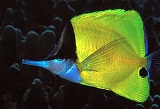
Forcipiger
Encyclopedia
Forcipiger is a genus
of tropical fish in the family
Chaetodontidae. They usually live in Australia
.
Genus
In biology, a genus is a low-level taxonomic rank used in the biological classification of living and fossil organisms, which is an example of definition by genus and differentia...
of tropical fish in the family
Family (biology)
In biological classification, family is* a taxonomic rank. Other well-known ranks are life, domain, kingdom, phylum, class, order, genus, and species, with family fitting between order and genus. As for the other well-known ranks, there is the option of an immediately lower rank, indicated by the...
Chaetodontidae. They usually live in Australia
Australia
Australia , officially the Commonwealth of Australia, is a country in the Southern Hemisphere comprising the mainland of the Australian continent, the island of Tasmania, and numerous smaller islands in the Indian and Pacific Oceans. It is the world's sixth-largest country by total area...
.
Species
- Yellow Longnose Butterflyfish, Forcipiger flavissimusForcipiger flavissimusThe Yellow Longnose Butterflyfish is a species of butterflyfish in the genus Forcipiger. It is also known as the Forcepsfish. It is similar in appearance to and found in the same range as the less common Forcipiger longirostris...
Jordan & McGregor, 1898 - Longnose butterflyfishForcipiger longirostrisForcipiger longirostris, commonly known as the Longnose Butterflyfish or Big Longnose Butterflyfish, is a species of butterflyfish found on coral reefs throughout the southern and western Pacific Ocean, as well as in portions of the Indian Ocean. It is easily confused with its more common cousin F....
, Forcipiger longirostrisForcipiger longirostrisForcipiger longirostris, commonly known as the Longnose Butterflyfish or Big Longnose Butterflyfish, is a species of butterflyfish found on coral reefs throughout the southern and western Pacific Ocean, as well as in portions of the Indian Ocean. It is easily confused with its more common cousin F....
(Broussonet, 1782)

